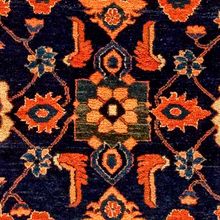Mahallat Rug
| Mahallat Rug | |
|---|---|
 Design of Mahallat Rug (Rugman) | |
| General information | |
| Name | Mahallat Rug |
| Original name | قالی محلات |
| Alternative name(s) | Mahallat Carpet |
| Origin | |
| Category | Village |
| Technical information | |
| Common designs | Herati, Medallion |
| Common colors | Ivory, Pink, Red, Navy Blue |
| Dyeing method | Natural, Synthetic |
| Pile material | Wool, Silk |
| Foundation material | Cotton, Silk |
| Knot type | Asymmetrical (Persian) |
Mahal rugs are produced in the town of Mahallat, located in the Arak (Markazi) Province of west central Iran. The rug weaving industry in the region can be traced back for centuries. Due to the location of Mahallat, the area rugs have a Kurdish influence as well as a Turkish influence. The fact that Mahal rugs feature both tribal and curvilinear designs can be directly attributed to the fact that Mahallat is located between the cities of Arak and Delijan. Skilled artisans may use either the Turkish or Persian knot, depending on the particular styles of area rugs that they are weaving.
History
Mahal, also known as Mahallat, is a town located in the Arak (Markazi) Province of west central Iran. Mahal carpets are known in the market from the last quarter of the nineteenth century.
Mahal carpet designs are semigeometric, with either medallion or allover patterns. Mahals are influenced by Sultanabad styles but have more motifs arrayed throughout the carpet. The designs have large palmettes with leaves and vines, Harshang (crab), Herati (fish), Minakhani (rosette-linked trellis), Open Field with center medallion, Maighan designs, and other traditional patterns.
Mahals generally have brick-red, dark blue, or ivory in the fields and borders. Shades of green, red, blue, beige, gold, camel, cinnamon, gray, and brown are used for the design elements and outlines. Mahals can be recognized for their soft handling and loosely woven texture. The carpets have a cotton foundation and a wool pile woven in the Persian (asymmetric) knot. They are made generally from medium to good in grade quality. Mahal formats range from small mats to large room-size carpets. Runners and gallery sizes can also be found in the old carpet market.
By the late twentieth century, some Mahal weavers switched from traditional designs to make carpets and rugs similar to other towns and villages in the region in accordance with domestic and foreign export demand.[1]
See also
| Search for Mahallat Rug on Wikipedia. |
References
- ↑ Moheban, 2015, 364-365
Bibliography
- Abraham Levi Moheban. 2015. The Encyclopedia of Antique Carpets: Twenty-Five Centuries of Weaving. NewYork: Princeton Architectural Press.